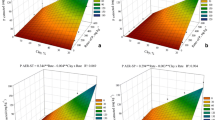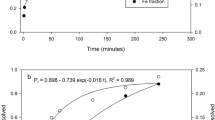Summary
The mechanism of radio-tagged tristearin removal from a glass substrate by sodium tripolyphosphate is primarily one of preferential displacement. Tristearin removal by STP appears to be a competition for primary polar adsorption sites: being the more polar, STP displaces the soil. Continuous soil films are more slowly removed than spotty soil films because initially fewer accessible adsorption sites are available for displacement attack by STP. It is believed that emulsification of these heavy films occurs initially by the ‘stripping” or preferential displacement by STP of the adsorbed monolayer at a site, followed by a rolling up of coherent soil along with the desorbed monolayer, resulting in a degree of emulsification.
In addition to its sequestrant water-softening action, previously considered its main function, and its detersive effectiveness, another very important feature has been discovered. Tripolyphosphate (and sequestrant type of anion) adsorbs on a glass surface and reduces the tenacity of subsequent fatty resoiling. This may account to a considerable degree for the demonstratedly high practical cleansing effectiveness of the compound.
Adsorption of STP is not by a base exchange mechanism for quartz also displays the same effect as glass. It seems apprarent that the same type of adsorption sites exists on both glass and quartz surfaces though those on quartz suggest either a stronger adsorption of a higher energy level or a larger number of adsorption sites.
These data demonstrate the relatively high detersive efficiency of the polyphosphates for this soil/substrate system. Sodium metasilicate and sodium carbonate fall considerably lower in soil-removal value.
Similar content being viewed by others
References
Anderson, R. M., Satanck, J., and Harris, J. C., J. Am. Oil Chemists’ Soc.,36, 286–294 (1959).
Hensley, J. W., J. Am. Cer. Soc.,34, 188 (1951).
Hensley, J. W., Long, A. O., and Willard, J. E., J. Am. Chem. Soc.70, 3146 (1948).
Hensley, J. W., Long, A. O., Willard, J. E., Ind. Eng. Chem.,41, 1415 (1949).
Willard, J. E., J. Phys. Chem.,57, 129 (1953).
Author information
Authors and Affiliations
About this article
Cite this article
Anderson, R.M., Satanek, J. & Harris, J.C. Removal of fatty soil from glass. Electrolyte detergent-builder effect. J Am Oil Chem Soc 37, 119–121 (1960). https://doi.org/10.1007/BF02644925
Received:
Issue Date:
DOI: https://doi.org/10.1007/BF02644925




